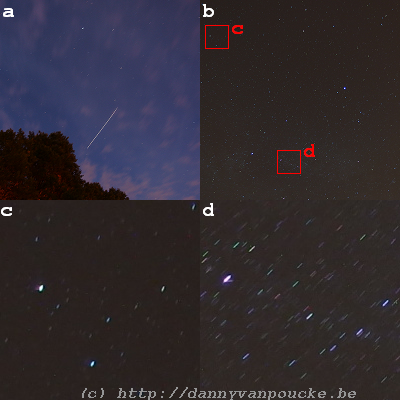What happens if two physicists take a holiday? They end up stargazing and hunting for the International Space Station (ISS). During the last week and a half we tried to capture the ISS flybys on camera nearly every night (with varying success). Each night we learned new things:

(a) Flyby of the ISS on August 4, 22h38 with a 20 second exposure, and ISO speed of 160. (b) Midnight starscape on august 5th (awaiting the ISS flyby) with a 60 second exposure at ISO-160. (c) and (d) zoomed in sections of (b) showing the color of the stars and arcs due to the earth rotation. (c) shows the a section of sky quite close to the north(small arcs). The arcs shown in (d) are about 15 arc-minute in size. (pictures by Sylvia Wenmackers)
- Prolonged exposure photography makes night-sky pictures very interesting:
- The overall sky quickly becomes overexposed (the least bit of final sunlight even after sunset, and the sky turn bright like it is midday, cf. picture (a))
- Stars truly have colors you can see.(I’m a city boy, and even though as a physicist I am well aware of this it didn’t really fully register before I saw our long exposure pictures with stars in colors varying from green to bright blue(cf. pictures (c) & (d)).⇒And my mind went racing toward a funky programming project to estimate the star’s temperatures.)
- During a 60 second exposure, the earth rotates 15 arc minutes which actually gives star-trails in our pictures…~7 pixels in the largest trails (cf. picture (d))
- During a 60 second exposure you can see a hell of a lot of stars, compared to what you normally see (further comparison to the starscape you have living in a city, you could as well be blind).
- The ISS flyby is very fast (at about 27600km/h), and appears to move faster across the sky than airplanes.
- With only a few minutes to trace an entire arc through the sky (NASA’s webpage shows times up to 6 minutes, but in reality the local horizon such as trees or houses can significantly reduce this.) The number of attempts to make a prolonged expose picture is limited to 2 or 3 (at best).
- With a size of ~100 m at an altitude of about 400 km the ISS has a relative size less than 1 arc-minute (or about 0.5 pixels)…so even with binoculars you are still looking at a very bright point.
- Timing is everything…especially if there are also other satellites passing by, following about the same path, at about the same time, such as the Lacrosse 5 spy satellite. Luckily there are many websites which can provide information on ISS flybys [e.g. here and here(in Dutch)] or any other satellite [here].

